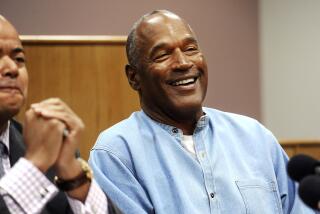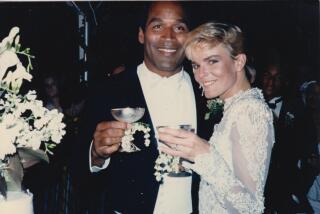O.J. Simpson saga as a history of race relations
- Share via
He was a symbol of racial unity who became a flashpoint of division.
O.J. Simpson moved with agility on and off the football field as a star running back, broadcaster and corporate pitchman. At the peak of his popularity, when he dashed through airports in 1970s Hertz commercials to the cheers of white onlookers, Simpson was seen as living proof that America could get past its race obsession.
The all-American image was shattered, of course, with his arrest for the 1994 slayings of his former wife, Nicole Brown Simpson, and her friend, Ron Goldman.
As one commentator put it, when the nation watched that slow freeway pursuit of Simpson while he held a gun to his own head, “All of a sudden, for mainstream white society, O.J. was a lot darker.”
Seven years after his controversial acquittal, HBO uses the Simpson saga as a penetrating lens on race relations in America since the turbulent late 1960s in “O.J.: A Study in Black and White,” presented tonight at 10.
Through interviews with athletes, educators and activists, this program from executive producers Ross Greenburg and Rick Bernstein offers heartfelt insights on Simpson’s rise and fall, shedding light on why the events of 1994-95 polarized the country along racial lines.
Though time lends perspective, feelings remain raw. Many whites still see a horrifying injustice where many blacks still see an overdue slap in the face to a society built on racism.
If Simpson’s career represented a harmony that might have been, the murder trial and the divergent reactions only prove that, so far at least, the dream is sheer fantasy.
More to Read
The complete guide to home viewing
Get Screen Gab for everything about the TV shows and streaming movies everyone’s talking about.
You may occasionally receive promotional content from the Los Angeles Times.






